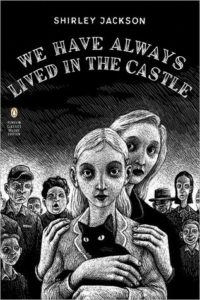After watching Bong Joon-ho’s Academy Award winning film Parasite, I was left wondering what makes a haunted house story a haunted house story. Do the houses in question have to have ghosts or phantoms or spirits? Creaky floorboards and cold spots? Is the threat of the supernatural enough to qualify an abode as haunted?
I’m inclined to say no. I think all a house needs to be haunted is a lot of unresolved personal dilemmas and a very large, very threatening elephant in the room. For example: repressed societal unrest that claws at the walls of the world to get out; lingering trauma from past experiences that you were either victim or perpetrator of; the unsettled prickliness of living on the edge of a big secret being unveiled. Whatever keeps you up at night, wandering your own hallways with a waifish bout of insomnia, from a leaky tap to the memory of an embarrassing attempt at public speaking when you were 12.
As with any good gothic story, ghosts represent the restlessness of the past and the refusal of a life—typically stolen from abused and violated persons—to stay quiet, instead pursuing vengeance or retribution. It is undeniable that our own ghosts, which can be dark memories, guilt manifesting as white sheets at the end of the hall, or a disturbing glimmer in the corner of our eyes, follow us throughout our everyday experiences and linger around our living spaces.
So, below is a list of books in which a household features as a prominent character or location that is definitely haunted, even despite the lack of creeping ghouls or monsters under the bed.
Stay with Me by Ayobami Adebayo
A tense story about the pressures and limits of love, this book follows Yejide and her husband as their marriage slowly unravels with the introduction of a second wife, demanding in-laws, and fertility struggles. When Yejide’s desire to keep her husband loyal by starting a family takes a turn for the tragic with the development of a phantom pregnancy, a catastrophic chain of events pulls their relationship into the darkest of places.
This novel has the markers of a perfect gothic novel, even though it lacks supernatural sightings. There is a solemn and isolated playroom which Yejide retreats to when mourning the loss of her children (phantom or otherwise), a death that drapes the house in mystery and tension, jealous doubles, and a threat of a curse. While the focus is on the psychological ramifications of the couples’ strained attempts at loving one another, and is placed relatively firmly in the natural world, there is an undeniable sinister suggestion of something otherworldly going on within the walls. Sometimes it can feel as though jumping to conclusions about ghosts trivialises the horrific things that humans do each other, however, this book does touch on the ways in which people may create unreasonable and supernatural justifications for their actions, which only further stresses to the reader the slipping grip these characters have on themselves.
 The Secret River by Kate Grenville
The Secret River by Kate Grenville
Set in the early 1800s, William Thornhill is deported to Australia from the UK after he is caught stealing. Once he arrives, Thornhill is possessed by a need for control and begins a gruesome war with the local Indigenous people for their land in order to establish his own new kingdom, fuelled only by colonial arrogance. It is a cautionary, controversial story of what happens when empathy is abandoned in favour of material desire, and how the dehumanisation of others quickly poisons and disfigures the self’s humanity.
Thornhill’s manor at the end of the book is far from grand, made with sharp angles and built on ground bloodied by hatred. The house is a poor and ugly imitation of grandeur, signifying Thornhill’s empty cruelty and insecurity with his own identity, and sounds almost inhospitable to anyone but its stubborn maker. What’s more, it is unquestionably haunted by the horrors Thornhill deliberately caused, as he believes he can hear the voices of the people he slaughtered underneath its floorboards, threatening and goading him, ready to pull his house out from underneath him. Grenville’s book tells us that the past will have its revenge, and will eventually return to ruin and collapse the foundations of institutions founded on atrocity.
 The House of Bernarda Alba by Federico Garcia Lorca
The House of Bernarda Alba by Federico Garcia Lorca
In response to the death of her husband, the eponymous Bernarda Alba forcibly quarantines her children in an extended period of mourning. As a result of prohibiting them from pursuing any relationships and her eagerness to keep her children contained within the walls of the house, their home boils with tension as Alba’s daughters begin to betray their mother’s wishes by rebelliously wearing colours, makeup, and secretly meeting boys. Unable to repress their desire for freedom, the sisters are soon at each other’s throats, desperately searching for any means of liberty, and soon tragedy sweeps through the house.
This Spanish play is fraught with ghosts; whether that be the husband’s memory suffocating the machinations of the household, the disembodied male lovers of the sisters who exist in whispered name only, or the looming pressure of the Spanish Civil War that rages outside the house’s walls. It is a story that has buried its characters alive before it begins, and examines the ways in which people combust when confined by arbitrary rules that deliberately reduce them to invisible spectres before they have a chance to fight for their humanity.
 Native Son by Richard Wright
Native Son by Richard Wright
The Dalton household in this novel is pristine and dresses itself up as welcoming to Bigger Thomas, a young Black man who has recently been employed as their personal driver. The inhabitants – a blind woman, a man who declares himself a philanthropist, and their Communist-in-training daughter – all treat Bigger with varying levels of false respect, stereotyping and patronising him while believing themselves to be sympathetic. The pressures of interpellation and threat of poverty grow until Bigger finds himself committing the novel’s horrific inciting incident, and he is suddenly forced to play by the rules of the household’s expectations and social dynamics for a chance at survival.
This book is probably one of the most stressful novels I’ve ever read, but my favourite gothic location in it is the Daltons’ basement, dark and brimming with secrets to be dug up. Furthermore, the book does a skillful job of subverting expectations and typecasting. Bigger would typically be considered the infiltrator of the home, with his presence reminding the family of their empty charity and role in the continued subjugation of Black people in the city. However, Bigger is undeniably the haunted one in the story, haunted by what the Dalton house represents, as he is constantly stalked and terrorised by various webs of lies and pitfalls set up by wealthy racists that lie in wait to trap him. Mrs Dalton appears seemingly out of nowhere at various points, Bigger is frequently possessed by a violent desperation to attack the systems that confine him, consumed by the fear and paranoia that the white upper-class brew and expect him to internalise to maintain their sense of control. Although the media in the novel paints Bigger himself as the monster, the events that take place in the Dalton house, and the institutional horrors that it comes to symbolise, is far more monstrous.
 We Have Always Lived in the Castle by Shirley Jackson
We Have Always Lived in the Castle by Shirley Jackson
The Blackwood house is devoid of ghosts in the traditional sense, but definitely far from spectre-free. Big sister Constance, younger sibling Merricat, and their uncle are the only surviving members of the family after the majority died at dinner six year ago. Now looked down on by the local village, the three of them keep themselves relatively hidden away from public life to avoid violence and shame, and do their best to keep their haunted past from coming to light.
This book is usually considered a horror because of the witchy atmosphere, as Merricat wishes she was a werewolf and nails books to trees in an attempt to exorcise the house of a greedy cousin who arrives to take the home for himself. However, it’s the pressure and anger from the community in the village below that forcibly turns the sisters into ghosts or monsters haunting the family tomb. Their disregard for their defences and fervour for violent retribution make them just as cruel as the sisters could be, showing the reader how even the ghost hunters can become the villains as they raid and invade in the name of justice.
Do you have a favourite haunted house story, or a book that is a horror novel in disguise? Let us know on social media!
Source : 5 Haunted House Stories (That Don’t Have Haunted Houses)











